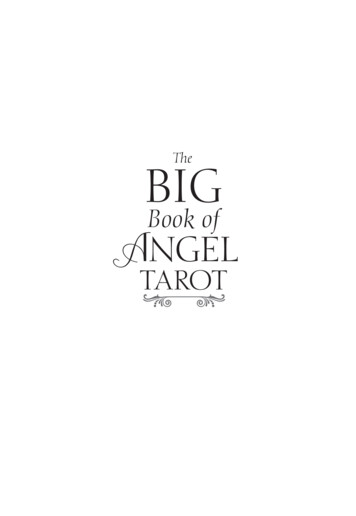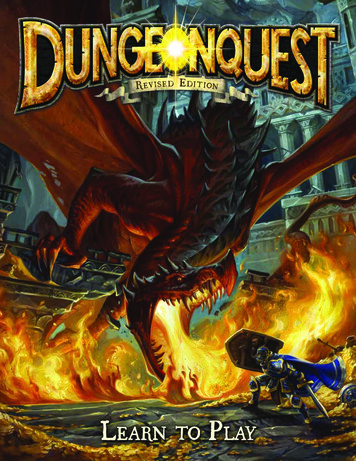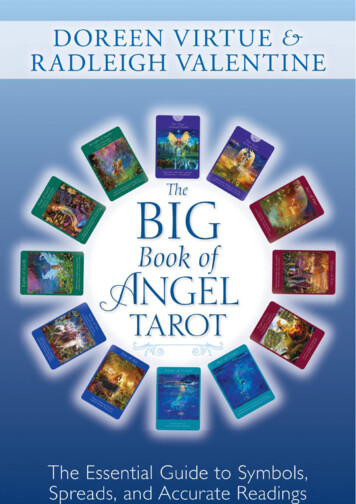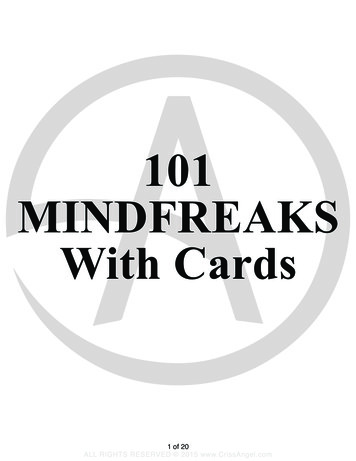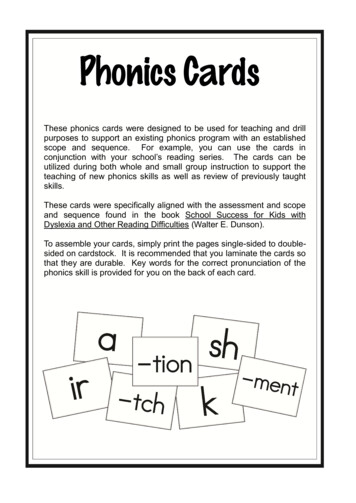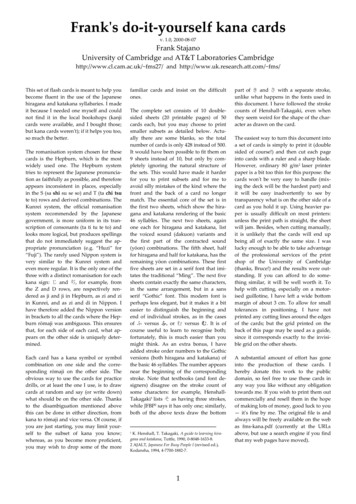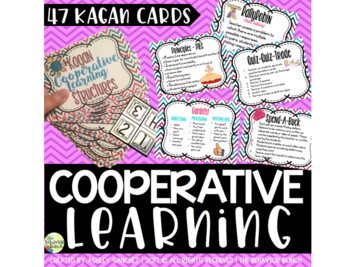
Transcription
CooperativeLearningRally Table{Pairs Writing}1. Teacher provides a task to whichthere are multiple possible responses.2. In pairs, students take turnspassing a paper and pencil (answerboard) or a team project, each writingone answer or making a contribution.2016 A. SanchezRally Robin{Pairs Talking}1.Teacher poses a problem towhich there are multiplepossible responses.2. In pairs, students take turnsstating responses or solutions.Round Table{Team Writing}1. Team shares one piece ofpaper2. Each person adds own idea toone list – passing around thepaper many times[good for brainstorming]
SUHUPU1. Teacher says, “Stand Up, Hand Up, Pair Up”2. Students stand up and keep one hand high in theair until they find the closest partner who’s not ateammate. Students do a ‘high five’ and put theirhands down.3. Teacher asks a question/gives a problem andprovides think time.4. Partners interact using: pair discussion,RallyRobin, Timed Pair Share.1.2.3.4.5.6.7.8.9.10.Rally Coach Round RobinShow DownTeams each have a set of question cards.Teacher selects one student on each team to be theShowdown Captain for the first round.The Showdown Captain draws the top card, reads thequestion, and provides think time.All students work alone to solve/respondWhen finished, teammates signal they’re readyShowdown Captain calls, “Showdown”Teammates show and discuss their answers.Showdown Captain leads the checking.If correct, the team celebrates; if not, teammates tutor,then celebrate.The person on the left of the Showdown Captainbecomes the Showdown Captain for the next round.Partners take turns, one solving aproblem while the other coaches.Then partners switch roles.Useful for any process orprocedure with a definiteright/wrong.{Team Talking}1.Teacher assigns a topic orquestion with multiple possibleanswers2. In teams, students respond orally,each in turn taking about the sameamount of time. (30 seconds each)
Corners1. Identify 4 “labels”, one for eachcorner.2. Have students select thecorner that best representsthemselves or their position.Draw-What-I-Say1.Students working in pairs make apicture but they don’t let the otherpair on the team see the picture.2. Students return to their team andattempt to communicate theirpicture with the other pair so wellthat the other pair can draw it.Line Ups1.2.3.4.The leader describes the line by height,birthdays, alphabetical by name, number ofpets, distance to vacation spot, length of lastname, length of hair, color of eyes, amountof jewelry, number of hours of sleep, middleinitial, etc.Participants line up.The line is split or folded to form pairs.Pairs discuss.Draw-What-I-Write1.2.3.4.5.Each student on a team of four makes a picturemaking sure the other teammates cannot see thepicture.Students then take time to describe their figure inwriting as clearly as possible.Students return to their teams and work in pairsexchanging written descriptions without showing theoriginal drawings.Teammates attempt to produce the figure from thedescription.Afterwards, pairs compare the originals with theattempts.
Jot Thoughts1. Students each have multiple slips of paper/post-its.2. Teacher names a topic, sets a time limit, andprovides think time. (“In three minutes how manyquestions can you write that have the answer 17?”“What are ways we can reduce poverty?”)3. Students write and announce as many ideas as theycan in allotted time, one idea per slip of paper.4. Each slip of paper is placed in the center of the table;students attempt to ‘cover the table’.Show Me!1. Teacher poses question2. All students white onwhiteboards3. Teach says “Show Me!”4. All students hold up boardsTeam Show Me!1. Teacher poses question2. All students in groups discussthe answer3. Team Lead writes the finalanswer on behalf of the group4. Teacher says “Show Me!”5. Team Lead holds up board
1.2.3.4.5.6.Fan-N-PickEach team receives a set of question cards,about 8 cards per team.Student #1 holds question cards in a fan andsays, “Pick a card”Student #2 picks a card, reads the question outload and allows five seconds of Think TimeStudent #3 answers the questionStudent #4 paraphrases the answer thatstudent #3 just gaveGroup praises or coaches 7. Students switchroles, one person clockwise for each new roundFist-to-Five1. Leader poses a statement.2. Participants raise fingersfrom one to five to indicatetheir position.Mind Mapping1. Teacher announces topic.2. Each student is given a different color penor marker and the team is given one largeposter sized piece of paper where theywrite the topic in the center in a rectangle.(i.e. Family)3. RoundTable on the core concepts (i.e., Pets,Kids, Mom, Dad, Vacation) in ovals.4. Add to the word web with additionalrounds or RoundTable or a free-for-all.Give-One, Get-OneSetup: give students a sheet of paper with twocolumns – Give-One and Get-One1. Students individually brainstorm to fill up theirGive-One column.2. When done, students stand.3. Students mix and find others. They Give-Oneidea/application to their partner and Get-One inreturn. Students write their partnersidea/application in the Get-One column.4. Students move on to find new partners.
Mix-Pair-Share1.2.3.4.5.Students mix around roomTeacher calls “Freeze”, “Pair”, or stops music,students pair up with the person closest tothem and do a high five. Those that haven’tfound a partner raise their hand.Teacher asks a question / gives a problem /gives vocabulary word / etc. and gives thinktimeStudents group according to the number ofthe answerRemaining students go to “Lost” and “Found”Numbered Heads Together1. Teacher prepares questions2. Students number off3. Teacher poses a problem/asks a question and givesthink time4. Students think and privately write their answers(paper, answer boards)5. Students lift up from their chairs to put their headstogether, show answers, and discuss and teach6. Students sit down when everyone knows the answeror has something to share and erase their boards.7. Teacher calls a number. The student with that numberfrom each team answerPairs Check1. Partner A solves the first problem/question2. Partner B watches and listens, checks, coaches andpraises3. Switch roles for another problem/question.4. Partner B solves another problem/question5. Partner A watches and listens, checks, coaches andpraises6. Both pairs (all four students in the group) reuniteand compare their answers. If they disagree andare unable to figure why, four hands go up.Otherwise, the team celebrates.Quiz-Quiz-Trade1.2.3.4.5.6.7.Teacher, or students, generatequestion/problem cardsStand up, hand up, pair up. Exchangegreetings.Partner A quizzesPartner B answersPartner A coaches or praisesSwitch rolesPartners trade cards & mix again
1.2.3.4.Spend-A-BuckEach person needs 10 play dollars.Options to be voted on are written onseparate cards or slips of paper. Thesecan be supplied by the teacher or writtenout by the students.Students put a dollar on each alternative.Students spend remaining dollars anyway they want.Teams count the results to determine theteam decision.Sum-the-Ranks1.Participants are provided with, or havecreated, a list of alternatives.2. Each team member ranks the items from thetop choice to the last choice. (The top choicegets the highest number)3. In teams, ranks are summed for eachalternative.4. Representatives from each team post theirsums. Team scores are totaled and the itemwith the highest score is selected.Stand-N-Share1. Teacher poses an issue.2. Teams discuss ideas.3. Students stand and share withthe large group.4. Students sit when all their teamideas have been shared.Take Off-Touch Down(Take Off if )1.Students stand (TakeOff) when they agreewith a statement.2. Students sit (TouchDown) when theydon’t agree/or itdoesn’t apply to them.
Talking Chips1. Teams have chips (two per person)2. Teacher provides a discussion topic andprovides think time.3. Any student begins the discussion, placing oneof his/her chips in the center of the table.4. Any student with a chip continues discussing,using his/her chip.5. When all chips are used, teammates eachcollect their own chips and continue thediscussion using their talking chips. Teams arenever finished (until teacher says/timer).Timed—Pair-Share1. Problem/Question is posed2. Students think alone for aspecified time3. Student A shares (30 seconds),then B Shares (3 seconds)4. Each team share with the class1.2.3.4.5.Pairs CompareTeacher provides a question that has multiplepossible responses and provides think time.Rally Table: Shoulder partners Rally Table answers.They ‘keep it a secret’ from the other pair.Teacher calls time.Pairs Compare: Pairs pair to Round Robin theiranswers. For each answer, the face partner in theother pair adds their answer to that pair’s list, orchecks it off if they already had it.Team Challenge: As a team, students generate newanswers, taking turns within pairs recordinganswers on their pair lists.
Find Someone WhoSetup: Teacher prepares a worksheet or problems,or questions for students.1. Students mix in the class, keeping a hand raiseduntil they find a partner2. In pairs, A asks B a question/problem, Bresponds. A records answer on answer sheet,expresses appreciation.3. B checks and initials.4. Partners switch, and repeat5. Partners shake hands, part, raise their hand andfind another partner to repeat the process untilworksheet is complete.1.2.3.4.5.6.7.Find-the-FictionTeammates write three statements/problems etc.: twotrue and one false.One student on each team stands and reads statementsto teammates.Without consulting teammates, each student writesdown his/her own best guess which statement is false.Teammates Round Robin (show guesses) and defendtheir ‘best guess’.Teammates announce their guess(es), or write themdown.Standing student announces the false statement.Students celebrate & Repeat process with anotherteammate.Gambits!greeting Hello! How areyou? Goodmorning! Good tosee you!praising Nice work! You triedreally hard! That was agreat idea. You did anexcellent job. You nevergave up!saying bye I’m glad Igot to workwith you. Keep up thegreat work. See ya later!Ways to Coach“I really like how you ”“What if you tried.”“Why did you ”“How did you.”“You did a fantastic job.”“What do you think about.”
Ask Questions/Call on Studentinstead use Round TableComplete a Worksheetinstead use Rally Table Rally Robin Talking Chips All-Write Round Robin Rally Coach Show Down Numbered Heads Together Use Task Cards for Fan-N-PickReviewing for a Quiztry usingAfter/During Lecturetry using Pairs Compare Quiz-Quiz Trade Numbered Heads Together Show Down Find Someone Who Talking Chips Round Robin Timed Pair Share Rally Robin
Get Students Up & Movingtry using SUHUPU Mix-Pair-Share Line Ups Find Someone WhoHowtoTeachaStructure Refer to it by name, so studentsbecome familiar with the differentstructures Post a visual of the steps Explain the steps Model with a group Have students practice & check forunderstanding Then officially beginDecision Makingtry using Spend-A-Buck Sum-the-Ranks Fist-to-Five CornersPrinciples - PIES Positive Interdependenceo(Does a gain for one student benefit another?) Individual Accountabilityo Each student must perform in front ofsomeone else. Equal Participationo Same turns/timed Simultaneous Interactiono Students feel engaged.
123bAb4A
1243bAbA
1243bAbA
1243bAbA
1243bAbA
1243bAbA
1243bAbA
1243bAbA
1243bAbA
1243bAbA
THANKYOU!for your purchaseTERMS OF USE:Good for one classroom/personal use only.No part of this product should be used forcommercial use.2016 A. Sanchezhttp://thebehaviorbunch.blogspot.com/please leavefeedback! Angeline VintageFONTS USED iN PRODUCT:KG Thinking Out LoudKG WHY YOU GOTTA BE SO MEANKG Two is better than oneKagan Structures & Clip Art Thanks to http://www.kaganonline.com/free articles/research and Kagan-Cooperative-LearningTPT: THE BEHAVIOR BUNCH
gives vocabulary word / etc. and gives think time 4. Students group according to the number of the answer 5. Remaining students go to "Lost" and "Found" 1. Teacher prepares questions 2. Students number off 3. Teacher poses a problem/asks a question and gives think time 4. Students think and privately write their answers (paper, answer .
